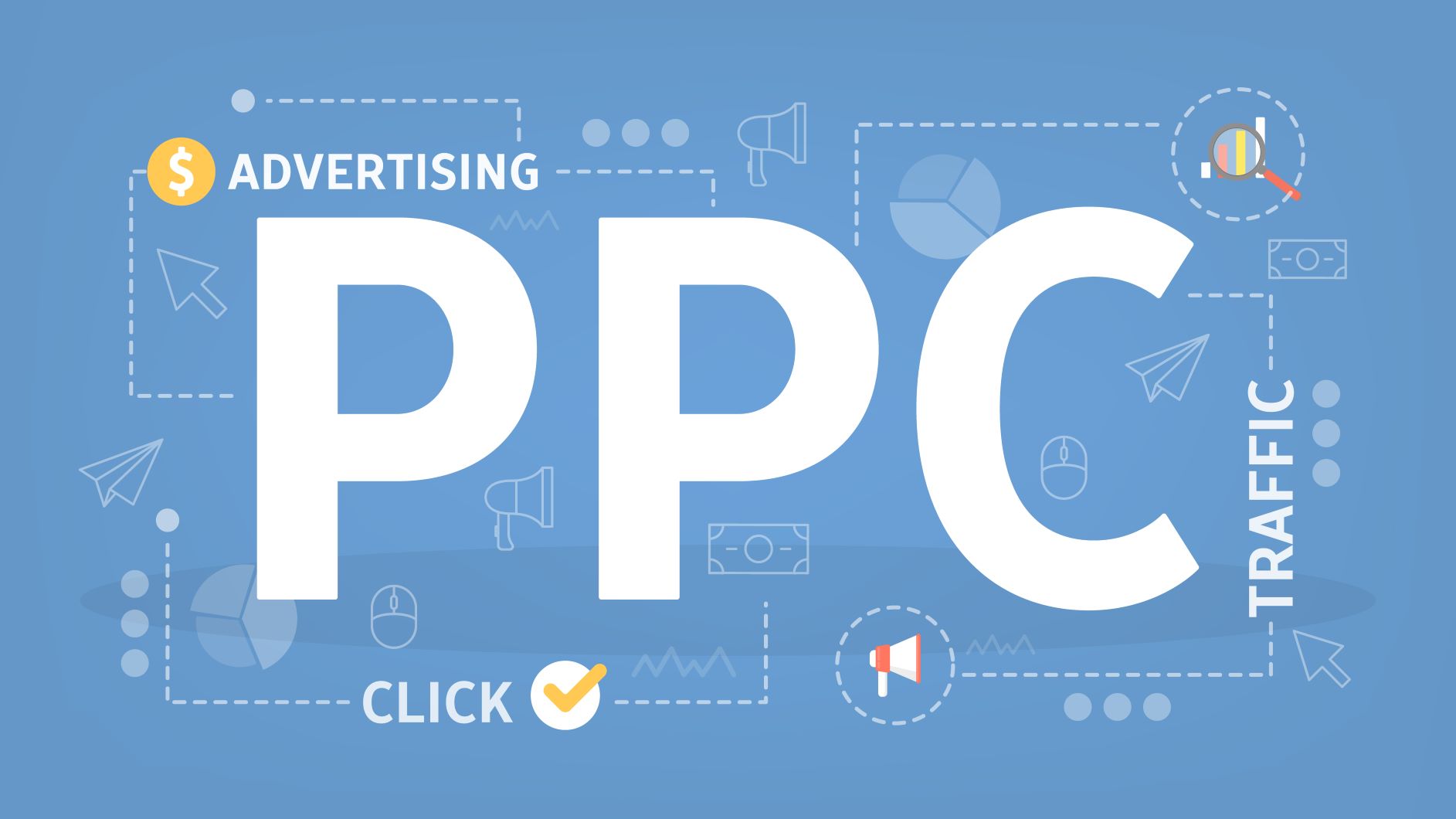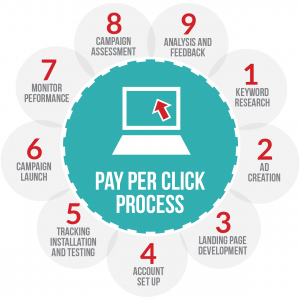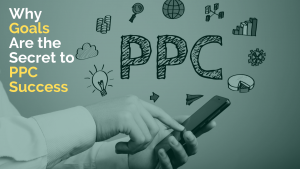02 Mar

Marketing through PPC proves to be the fast track solution for any business to gain effective and efficient branding. Applying the techniques of PPC can help you achieve marketing goals, other than just profits.
A solid PPC strategy is the key to planning, executing, and optimizing paid ad campaigns. Without a paid search strategy, you’re at risk of spending your budget reactively; with a strategy, you can build and refine a targeted, goal-focused ad campaign.
Implementing a pay-per-click (PPC) campaign is one of the most effective ways to boost your brand presence and get new leads. If managed successfully, you can maximize your return on investment (ROI) by 50% or even more. A successful PPC campaign requires a lot of research and strategic planning.
What is PPC?
PPC (pay-per-click) marketing is a form of online advertising in which advertisers accrue costs when users click their ads. Advertisers bid on the perceived value of a click in relation to the keywords, platforms, and audience type in which it originates.
The Basics
PPC is used for all types of campaign goals, including:
- Increasing sales
- Generating leads
- Promoting brand awareness
PPC is all about relevance. Users are searching for specific products, services, and information at any given time. Advertisers have the ability to show a targeted ad at the exact moment this search is occurring. For example, if a user searches for “blue running shoes,” an advertiser can show an ad speaking to “blue running shoes.”
Plan your PPC strategy
See how to plan your PPC strategy to make it successful.
1. Set up your goals and budget
The main focus of the goal set up for your PPC campaign is a conversion after all. For instance, you have developed a strategy for your PPC campaign but still not generating profit and driving conversions, then it’s not worth it.
In order to set up your PPC campaign goals, you need to find out the type of goal, through the campaign. Goals can vary from bringing in traffic to just getting the clicks, to driving increased revenue, to sales and conversion. Whatever the goal is for your PPC advertising campaigns, it should be in alignment with the overall digital marketing strategy. The PPC campaigns should be well versed and resonating with organic search marketing, the social media marketing, the content marketing campaigns and so on.
However, it should be kept in mind that the PPC advertising strategies aren’t poles apart from the goals already set for your business. As the pay per click campaigns are bidding based on targeted keywords, the number of organic searches on those targeted keywords should also be taken into consideration.
2. Diversified keyword research
Keyword research has always been the jack of all trades. Whether the organic search ranking, the advertising and the marketing activities referred, targeting for the wrong set of keywords has never been the key. It is just that with the paid advertising, the scenario for a keyword-based targeting is approached differently.
Additionally, the searches made by the users are mostly those rich keywords that the advertisers want to bid on for maximum growth. The broad match, the phase or the exact match, all have different intentions with the former being close to the generic nature of search queries, and the latter brings in much of preciseness in the searches, thus refining the intention.
When the search query is typed, the auction begins, the advertisement with the best results flashes on the searches for the targeted keyword.
3. Analyze your competitor thoroughly
Analyzing your competitor has been one of the main pillars for setting up your PPC ad campaigns. Knowing the competitor tells you, the aggressive approach your competitors are having with reference to targeting the audience that you also eye on. For more precision use Alexa’s Audience Overlap tool, SEMrush, Ahrefs, Moz Pro, etc., to identify sites competing for your audience.
Analyzing the various matrices when you have to come on level terms with your competitor is by far the best strategy for setting up your campaign. The A/B testing method for comparing the ad copies to bring out the best in them to be worked with. This ensures that when you are on the battlefield with competitors, you serve the best intended and dynamically targeting ads.
Goals for PPC strategy
Let’s have a look at PPC goals and tactics that will help you accomplish each one.
1. Brand Awareness
PPC is usually used for brand awareness to introduce and raise the visibility of a brand or product. Using PPC display ads can be effective if the targeting is on-topic by using keywords, topics, relevant placements, in-market lists, or a combination of those.
These targeting tactics are the most general but will offer a wider reach. Social media PPC ads are a good option for branding since there are so many targeting options based on demographics and interests. Similarly, search campaigns with more general keywords can be useful for branding.
The downside of this approach is that you will often see higher cost-per-clicks due to competition and sometimes irrelevant click-throughs. The best way to execute this approach is with smart keyword match types and negative keywords.
2. Product & Brand Consideration
In this phase, when users are considering and researching a purchase, it is a great time to reintroduce the brand with more detailed targeting and more persuasive call-to-action language in the ad copy.
When consumers hit the considerations phase, typically, their search queries will become more detailed and specific. They may search for brands and product combinations to research, compare, and read reviews such as ‘Samsung 50” TV’ or ‘LG 50” tv’.
This is a good time to use remarketing with a banner or responsive ads to bring the consumer back to the previously viewed product. Another excellent form of targeting is the in-market list composed of users whose online behavior and action have indicated they are in the market to buy.
3. Leads
When your business model doesn’t support immediate or online sales, you want to collect leads to follow up with interested prospects and engage them in a conversation. Calls-to-action might be:
- Request a demo.
- Get a consultation.
- Free trial.
All of these ideas are meant to entice the user to call or fill out an online web form to initiate conversions. How the lead is followed-up on will vary for each business, but now you also have information that can be used for PPC and paid social customer match campaigns.
4. Sales
Consumers who are ready to purchase tend to use words in their search queries that indicate higher intent. This can include things like:
- Model numbers.
- Shipping information.
- Discounts.
- Coupons.
- Financing.
It is good to have separate campaigns that address this phase by highlighting offers, guarantees, warranty information, or your return policy. This reassures consumers that your business is the one to buy from. Make full use of your ad copy and ad extensions. Try cart abandonment ads and remarketing ads that show the products the user viewed. Also, set up the remarketing campaigns so that customers are no longer targeted after the purchase.
5. Repeated sales
PPC is an excellent way to gather repeat sales if your product or service needs replacement, maintenance, accessories, upgrades, or other product cross-sells or up-sells. In designing the repeat sales approach, ask a few questions:
- How long does the product last or need to be replaced?
- Is there a new and improved model coming out?
- Does the consumer buy multiples?
- Are there opportunities to cross-sell accessories or complementary products?
- What would motivate the consumer to re-purchase from you? Brand loyalty? Fast shipping? Unique features?
Use PPC remarketing and customer match to re-engage previous customers with messaging aimed at factors that would motivate them to purchase from you again.
Setting Your PPC Goals: Why Is It Important?
Just like search engine optimization (SEO) and other digital marketing strategies, goal setting is the initial and most important step when launching a PPC campaign. This determines the strategy and project workflow. Without knowing your objectives, it can be difficult for you to track your progress and measure success.
Before creating a PPC plan, take the time to think about your business goals. This should help you identify your specific objectives allocated to your paid ads campaigns and budget, as well. You can start by asking yourself questions like:
• What am I trying to accomplish with my paid ads?
• Also, what are the most important metrics in my business?
• And, what outcome do you foresee?
• Does your business work from leads?
Asking these questions and clearly defining your goals will help you make the right decisions when going through your workflow. And clearly defining your goals will help you make the right decisions when going through your workflow.
How to set goals for your PPC campaigns
1. Assess your business needs
As mentioned earlier, considering your business needs will also help identify your goals for your PPC campaigns. What are you trying to achieve from your paid search ads? Why do you think your business needs a pay-per-click strategy? Answering these questions puts you in the right direction when creating a PPC plan that aligns with your business goals.
2. Define achievable and challenging goals
Set clear, specific and realistic PPC goals. On the flip side, goals should be challenging and may involve complex steps to achieve. If the goals are too easy, what’s the point? Each goal should inspire you and your team because it’s challenging — but with the strategic planning and data-driven solution (and a bit of tenacity), it’s totally achievable.
3. Establish short and long term goals
In PPC, you can set goals for any timeframe. They could be weekly, bi-weekly, monthly, quarterly or annually — depending on the scope of your campaigns. Establishing goals for these timeframes is ideal for PPC campaigns. Short-term goals create benchmarks for a wider scope or high-level accounts. On the other hand, long-term goals determine the overall performance of your pay-per-click strategy.
When setting goals for your PPC campaigns, make sure you’re looking at similar timeframes that provide parallel comparisons. This makes it easier for you to gauge your campaign’s performance.
4. Focus on the output of your campaign
If you set a goal of “adding 300 new keywords to my account,” you might need to rethink your goals. Take note that goals should focus on the output of your efforts, not the input. Focus on results, not the strategy to reach your objectives. This is a common mistake for some businesses and digital marketers.
Rather, your goal should indicate: “By January 2020, we will increase sales by 3% over December 2019 and decrease our cost-per-acquisition (CPA) by 1%.” Once you’ve established specific goals, then it’s time to identify the strategy to get you there.
5. Set baseline and stretch goals
Setting goal tiers provide more direction to your PPC campaign. It also motivates your team more. The baseline goal serves as a threshold for success; while the stretch goals are usually the overwhelming objectives.
6. Analyze goal performance
Analyzing goal performance is vital to every digital marketing campaign. Don’t just focus on hitting the goal. You also need to determine why or how you achieved the results. The same thing goes for objectives you didn’t hit. Find out the root cause and how to resolve them. Remember, learning is the best thing you can get from this process.
How can PPC help you grow your business?
Applying the techniques of PPC can help you achieve marketing goals, other than just profits. PPC supplements goals including but not limited to: brand exposure, leads, content downloads, contests, newsletter sign-ups, website traffic and of course conversions.
When strategizing for campaigns, you need to identify your personal company objectives, and how they relate to PPC. One company may just be looking for ways to get more eyes on their website and its content. While another may be making a huge sales push.
Conclusion
Remember that in the digital marketing ecosystem, the PPC Campaign for any advertiser thrives on fruitful results, when they are running the campaign with a calculated approach under the paid search strategy. Don’t just throw away your budget getting carried away with the excitement for your bidding; plan your venture for the perfect pay per click marketing. Set the campaign objectives and goals beforehand, search for the target market, understand your buyer persona, analyze what your competitors are doing, this would refine the bidding strategy set up for a particular campaign.
As a part of your overall marketing strategy, focus on execution and optimization activities for achieving greater returns on the ads spent. But, working with your paid strategy does not imply that you focus less on the other inbound marketing activities and the organic presence. Working on set patterns on different platforms, you can target for higher audience boosting sales and thereby shooting the revenue up.


